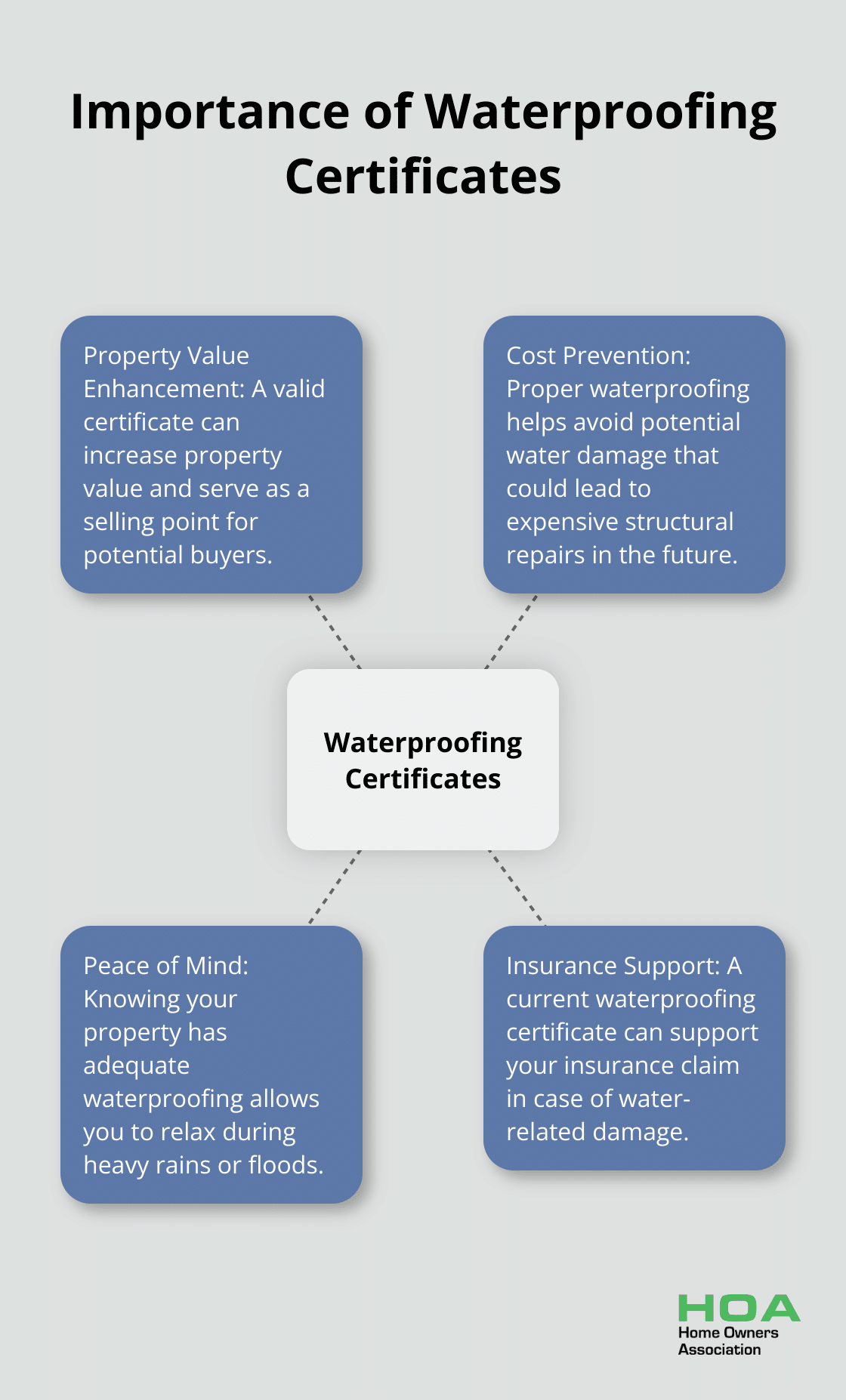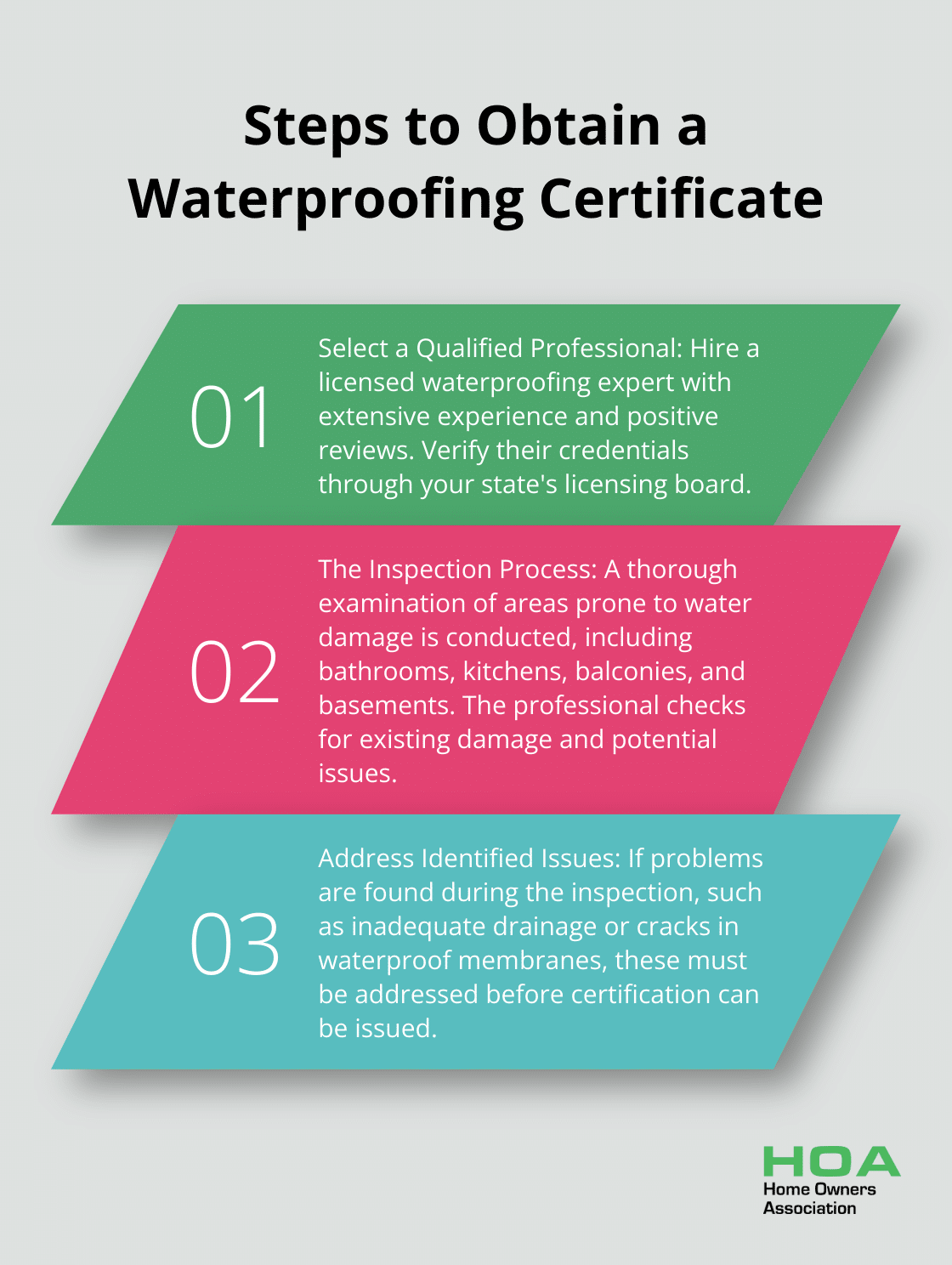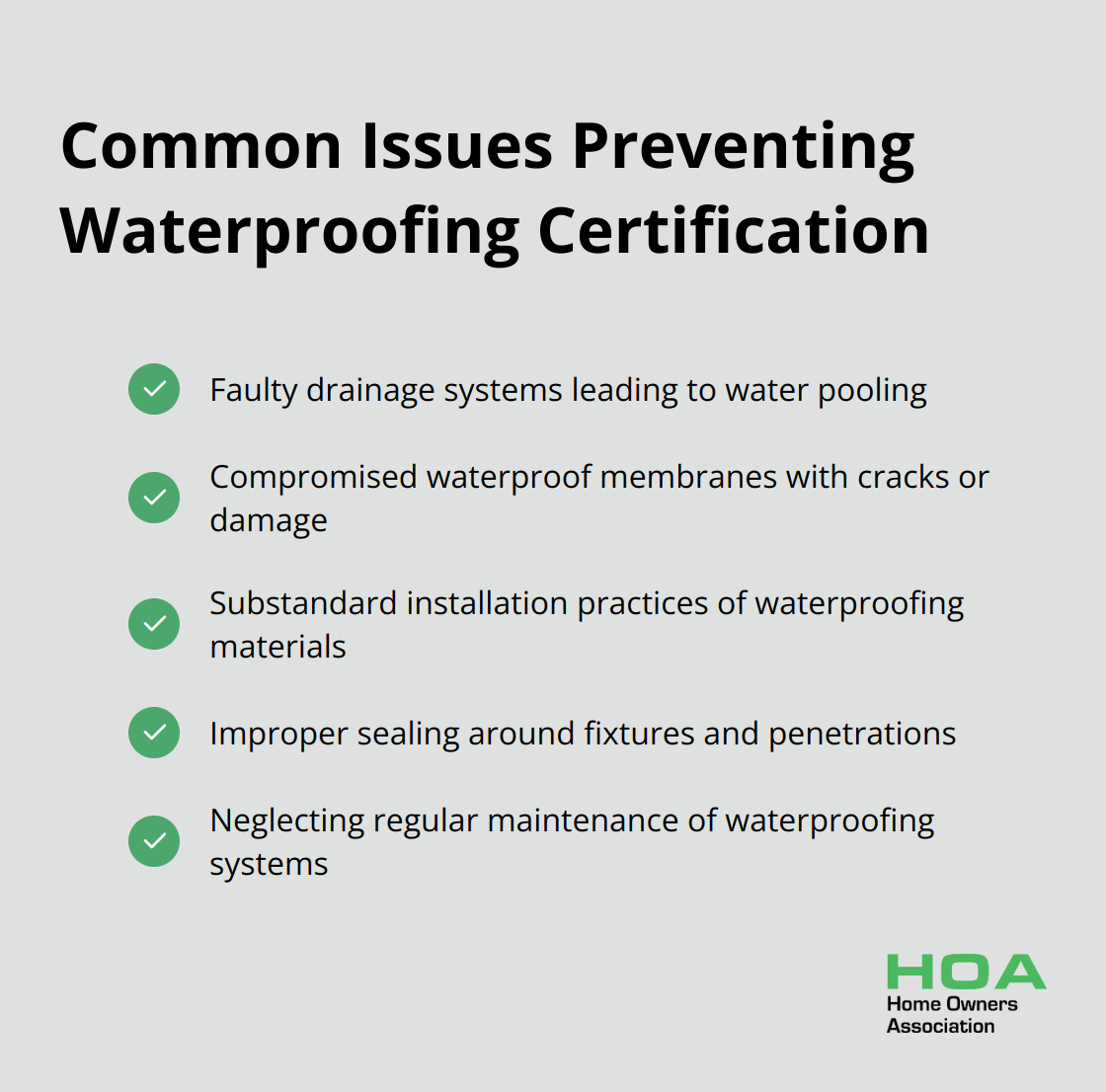
At Home Owners Association, we understand the importance of protecting your property from water damage. A waterproofing certificate is a crucial document that verifies the effectiveness of your home’s waterproofing systems.
This certification not only ensures your property’s structural integrity but also complies with legal requirements. In this post, we’ll guide you through the process of obtaining a waterproofing certificate and highlight its significance for homeowners and property managers.
What Are Waterproofing Certificates?
Definition and Purpose
Waterproofing is any protective treatment of a home to prevent water or moisture getting into it. It is also the protective treatment of wet areas of a home. Waterproofing certificates are official documents that verify the effectiveness of a property’s waterproofing systems. Licensed professionals issue these certificates after a thorough inspection of the waterproofing measures in place. These documents serve as proof that a building’s waterproofing systems meet the required standards. They detail the areas inspected, the methods used, and confirm compliance with Australian waterproofing standards.
Legal Requirements
The legal landscape for waterproofing certificates in Australia varies by state and local council. For example, in New South Wales, the Home Building Act 1989 requires certification for certain waterproofing work. Failure to obtain proper certification can result in significant fines. It’s important to check with local authorities for specific requirements in your area.
Importance for Property Owners
For homeowners and property managers, waterproofing certificates offer more than just legal compliance. They provide a safeguard for your investment in several ways:
- Property Value Enhancement: A valid waterproofing certificate can increase property value, serving as a selling point for potential buyers.
- Cost Prevention: Proper waterproofing helps avoid potential water damage that could lead to expensive structural repairs in the future.
- Peace of Mind: Knowing your property has adequate waterproofing allows you to relax during heavy rains or floods.
- Insurance Support: A current waterproofing certificate can support your insurance claim in case of water-related damage.

Benefits of Certification
Waterproofing certificates offer tangible benefits to property owners:
- Quality Assurance: The certification process ensures that waterproofing work meets industry standards.
- Early Problem Detection: Inspections for certification can identify potential issues before they become major problems.
- Compliance Documentation: Certificates provide proof of compliance with building codes and regulations.
- Professional Assessment: Licensed experts conduct thorough evaluations of your property’s waterproofing systems.
The importance of waterproofing certificates extends beyond mere paperwork. They represent a commitment to maintaining the structural integrity and value of your property. As we move forward, let’s explore the steps you need to take to obtain a waterproofing certificate for your property.
How to Obtain Your Waterproofing Certificate
Selecting a Qualified Professional
The first step to obtain your waterproofing certificate is to hire a licensed waterproofing professional. In Australia, waterproofing work valued at less than $3300 does not require a licence, but you may need to provide evidence (a certificate or statement) for the work. To find a reputable expert, check the licensing board in your state. For instance, in New South Wales, you can verify a contractor’s credentials through the NSW Fair Trading website.
When you select a professional, look for someone with extensive experience and positive reviews. Ask for references and examples of their previous work. The choice of the right expert is essential for ensuring your waterproofing meets all necessary standards.
The Inspection Process
After you choose a professional, they will schedule an inspection of your property. This typically involves a thorough examination of all areas prone to water damage, such as bathrooms, kitchens, balconies, and basements.
During the inspection, the waterproofer will check for signs of existing water damage, assess the condition of current waterproofing systems, and identify potential problem areas. They may use specialised equipment (like moisture meters) to detect hidden issues.
Addressing Identified Issues
If the inspection reveals any problems, you will need to address these before a certificate can be issued. Common issues include inadequate drainage, cracks in waterproof membranes, or improper sealing around fixtures.
Your waterproofing professional will provide a detailed report of their findings and recommend necessary repairs or improvements. It’s important to address these issues promptly to prevent further damage and ensure your property meets certification standards.
Finalizing Your Certificate
Once you complete all necessary work and your property’s waterproofing systems meet the required standards, you will receive your waterproofing certificate. This document should detail the areas inspected, methods used, and confirm compliance with Australian waterproofing standards, which include references to weatherproofing provisions in Australian Standards for masonry, autoclaved aerated concrete and metal wall sheeting.
Keep this certificate in a safe place, as you may need it for insurance purposes, property sales, or future renovations. We recommend keeping digital copies as well for easy access and sharing when needed.

Maintaining Your Certification
Waterproofing certificates aren’t a one-time thing. Regular inspections and maintenance are key to keeping your property protected. Try to schedule annual check-ups to ensure your waterproofing remains effective and up to code. This proactive approach will help you identify and address potential issues before they become major problems (saving you time and money in the long run).
As we move forward, let’s explore some common issues that may prevent certification and how to address them effectively.
What Can Prevent Waterproofing Certification?
Faulty Drainage Systems
Inadequate drainage often prevents waterproofing certification. Poor drainage leads to water pooling, which puts excessive pressure on waterproofing membranes. The Australian Building Codes Board points out that improper falls in wet areas frequently cause issues. Your drainage slopes should have a minimum fall of 1:100 for adequate water runoff. Properties with flat or reverse-sloping surfaces might need additional drainage systems to prevent water accumulation and potential damage.
Compromised Waterproof Membranes
Cracks or damage in waterproof membranes create another common certification roadblock. These issues often result from subpar materials, improper application, or wear and tear over time. Water ingress from failed waterproofing is one of the most widespread building defect issues in Australia. Regular inspections can catch these problems early. Address any cracks, bubbles, or separations in your waterproofing membrane immediately with professional repair or replacement.
Substandard Installation Practices
Poor installation of waterproofing materials frequently leads to certification failure. This includes using the wrong products for specific applications or not following manufacturer guidelines. To avoid this, hire licensed professionals with proven track records. Ask for references and check their credentials before you start any waterproofing work.
Improper Sealing Around Fixtures
Inadequate sealing around fixtures and penetrations creates another critical issue that can prevent certification. These areas are particularly vulnerable to water ingress if not properly waterproofed. Pay special attention to shower recesses, bathtubs, and any areas where pipes or electrical conduits penetrate walls or floors. Use high-quality, flexible sealants designed for wet areas, and ensure that all penetrations have proper flashing and sealing according to Australian Standards.
Neglecting Regular Maintenance
Lack of regular maintenance can lead to certification issues. Even well-installed waterproofing systems degrade over time due to wear and tear, environmental factors, and structural movements. Try to schedule annual inspections (preferably by a licensed professional) to identify and address potential problems before they escalate. This proactive approach not only helps maintain certification but also prevents costly repairs down the line.

Final Thoughts
A waterproofing certificate proves that your property’s waterproofing systems meet required standards. This document provides peace of mind and can increase your property’s value. Proper waterproofing protects against structural damage, prevents mould growth, and preserves your home’s aesthetic appeal.
We at Home Owners Association urge homeowners and property managers to prioritise regular inspections of their waterproofing systems. Identifying potential issues early can prevent major problems and save money. Waterproofing is an ongoing commitment to your property’s well-being, not a one-time task.
Schedule annual check-ups with licensed professionals to maintain your waterproofing certificate (and protect your investment). Take action today to secure your waterproofing certificate and safeguard your home’s future. Don’t wait until water damage occurs to address potential waterproofing issues.





